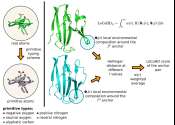New process could slash energy demands of fertilizer, nitrogen-based chemicals
Nitrogen-based synthetic fertilizer forms the backbone of the world food supply, but its manufacture requires a tremendous amount of energy. Now, computer modeling at Princeton University points to a method that could drastically ...









